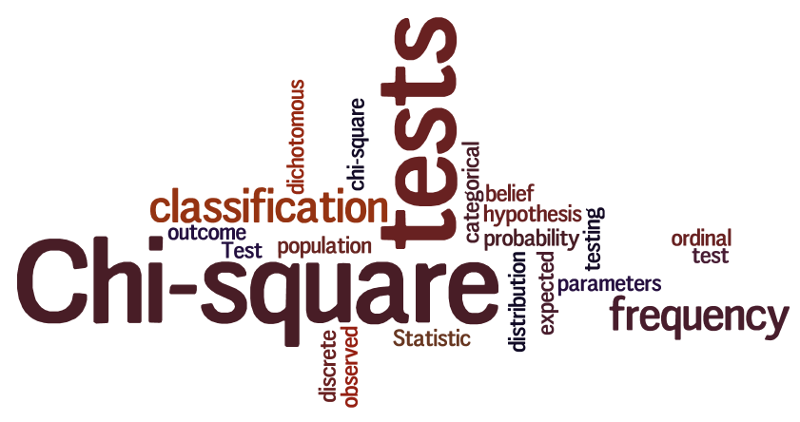What is Chi-Square Test Statistics?
The Chi-Square test is used to determine if there is any significant relationship between two or more categorical variables.
Chi-square statistics, also known as the chi-square test, is a statistical method used to test the association between two categorical variables. It is a non-parametric test, which means it does not make any assumptions about the underlying distribution of the data.
The chi-square test is used to determine whether there is a significant relationship between two categorical variables by comparing the observed frequencies with the expected frequencies under the null hypothesis of independence. If the observed frequencies are significantly different from the expected frequencies, then the null hypothesis is rejected, and it is concluded that there is a significant association between the two variables.
Assumptions of the Chi-Square test:
Here are some of the key limitations and assumptions of the chi-square test:
Independence of observations: The chi-square test assumes that the observations are independent of each other. This means that each observation must be independent and not influenced by any other observations.
Sample size: The chi-square test assumes that the sample size is large enough to approximate the true population distribution. As a rule of thumb, the expected frequency for each category should be at least 5.
Frequency counts: The chi-square test assumes that the data is measured at the nominal or ordinal level, and that the frequency counts are used instead of continuous measurements.
Random sampling: The chi-square test assumes that the data is obtained from a random sample. This means that each member of the population has an equal chance of being selected for the sample.
Homogeneity of variance: The chi-square test assumes that the variance of each group or category is approximately equal. If the variances are unequal, the test may be less reliable.
Normality: Although the chi-square test is robust to departures from normality, it assumes that the data is distributed according to a normal distribution.
Non-negative values: The chi-square test assumes that all values are non-negative.
It is important to consider these limitations and assumptions when interpreting the results of the chi-square test. Violations of these assumptions can affect the accuracy and validity of the results.
Example:
Suppose a market research firm conducted a survey of 1000 people to investigate the relationship between gender and smoking status. The results of the survey are summarized in the following contingency table:
Smoking Status | ||
Gender | Smoker | Non-Smoker |
Male | 200 | 400 |
Female | 100 | 300 |
To test the hypothesis that gender and smoking status are independent, we can use the chi-square test. Here are the steps:
Step 1: State the null and alternative hypotheses
The null hypothesis is that there is no association between gender and smoking status. The alternative hypothesis is that there is a significant association between gender and smoking status.
H₀: Gender and smoking status are independent
H₁: Gender and smoking status are not independent
Step 2: Calculate the expected frequencies
The expected frequency for each cell is calculated using the formula:
Expected frequency = (row total x column total) / grand total
The expected frequencies for our example are:
Smoking Status | ||
Gender | Smoker | Non-Smoker |
Male | 240 | 360 |
Female | 60 | 340 |
Step 3: Calculate the chi-square test statistic
The chi-square test statistic is calculated using the formula:
χ² = ∑(O – E)² / E
where O is the observed frequency and E is the expected frequency.
The calculations are as follows:
χ² = [(200 – 240)² / 240] + [(400 – 360)² / 360] + [(100 – 60)² / 60] + [(300 – 340)² / 340]
χ² = 28.67
Step 4: Determine the degrees of freedom
The degrees of freedom are calculated as:
df = (r – 1) x (c – 1)
where r is the number of rows and c is the number of columns.
In our example, there are 2 rows and 2 columns, so the degrees of freedom are:
df = (2 – 1) x (2 – 1) = 1
Step 5: Determine the p-value
The p-value is the probability of obtaining a chi-square test statistic as extreme or more extreme than the observed value, assuming the null hypothesis is true. It is calculated using a chi-square distribution table with the degrees of freedom and the significance level.
Assuming a significance level of 0.05 and one degree of freedom, the critical value is 3.84. Since the calculated chi-square test statistic is greater than the critical value, we can reject the null hypothesis and conclude that there is a significant association between gender and smoking status.
Step 6: Interpret the results
The results of the chi-square test indicate that there is a significant association between gender and smoking status. Specifically, the observed frequencies are significantly different from the expected frequencies, suggesting that gender and smoking status are not independent variables.
In this case, we can reject the null hypothesis and conclude that there is a relationship between gender and smoking status. However, the chi-square test does not tell us the nature or direction of the relationship. To determine the strength and direction of the relationship, additional statistical tests or methods may be needed.
It is also important to consider the limitations of the chi-square test. Like any statistical test, the chi-square test has assumptions and limitations that need to be considered when interpreting the results. For example, the chi-square test assumes that the observations are independent and that the expected frequencies are greater than or equal to 5. Violations of these assumptions can affect the accuracy and validity of the results.
Overall, the chi-square test is a useful tool for analyzing categorical data and detecting relationships between variables. It can be applied in various fields such as social sciences, business, and healthcare, among others, to answer research questions and make informed decisions.

